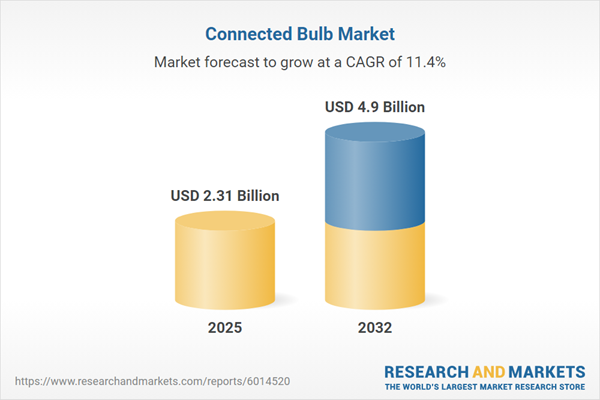Speak directly to the analyst to clarify any post sales queries you may have.
The connected bulb market is undergoing substantial transformation as intelligent lighting rapidly becomes a priority across commercial and residential spaces. This evolving landscape is being shaped by technological advancement, regulatory change, and new approaches to energy management.
Market Snapshot: Connected Bulb Market Growth and Opportunity
The connected bulb market grew from USD 2.07 billion in 2024 to USD 2.31 billion in 2025 and is forecasted to sustain double-digit annual growth, reaching USD 4.90 billion by 2032 at a CAGR of 11.38%. This momentum reflects a shift from traditional lighting to smart, data-driven solutions in consumer and institutional environments. The expansion is supported by increasing demand for systems that offer control, energy efficiency, and adaptability, with new applications emerging across diverse segments from smart homes to large-scale infrastructure upgrades.
Scope & Segmentation of the Connected Bulb Market
This research offers comprehensive analysis of the connected bulb ecosystem, spanning product types, deployment applications, and supply channels:
- Connectivity: Bluetooth, Wi-Fi, Zigbee
- Application: Commercial (hospitality, office, retail), Industrial (manufacturing, utilities), Residential
- Installation: Indoor (ceiling fixtures, table lamps), Outdoor (landscape, street lighting)
- Light Color: RGB, RGBW, Tunable White, White (cool white, warm white)
- Sales Channel: Offline (mass merchants, specialty stores), Online (e-commerce platforms, manufacturer websites)
- Regional Coverage: Americas (North America: United States, Canada, Mexico; Latin America: Brazil, Argentina, Chile, Colombia, Peru), Europe, Middle East & Africa (Europe: United Kingdom, Germany, France, Russia, Italy, Spain, Netherlands, Sweden, Poland, Switzerland; Middle East: United Arab Emirates, Saudi Arabia, Qatar, Turkey, Israel; Africa: South Africa, Nigeria, Egypt, Kenya), Asia-Pacific (China, India, Japan, Australia, South Korea, Indonesia, Thailand, Malaysia, Singapore, Taiwan)
- Company Analysis: Signify N.V., ams-OSRAM AG, Sengled Smart Home Technology Co., Ltd., Xiaomi Corporation, TP-Link Technologies Co., Ltd., Feit Electric Company, Inc., GE Lighting LLC, Buddy Technologies, Inc., Nanoleaf Labs Inc., Leviton Manufacturing Company, Inc.
Key Takeaways for Senior Decision-Makers
- The connected bulb segment underpins the shift to intelligent building ecosystems, enabling seamless integration with voice assistants, automation platforms, and mobile controls for both consumers and enterprises.
- Industry convergence around new protocols like Thread and Matter is driving heightened device interoperability, simplifying cross-brand deployments in commercial, industrial, and residential environments.
- Advanced power management, miniaturized components, and embedded machine learning enable adaptive lighting that enhances occupant comfort, productivity, and potential wellness outcomes across multiple verticals.
- Dynamic supply chain models, modular manufacturing, and regional sourcing strategies are improving operational resilience, especially in the face of regulatory adjustments and shifting tariff regimes.
- Competitive strategies span from ecosystem partnerships to differentiated channel approaches, addressing the growing demand for user-centric and value-added lighting solutions.
Tariff Impact: Navigating Regulatory and Cost Complexities
Recent US tariff policy adjustments have introduced new cost and sourcing pressures for connected bulb stakeholders. Raised duties on certain lighting categories have prompted manufacturers to optimize supply chains through regional diversification and local assembly. Distributors and procurement teams are seeking exemptions and leveraging alternate trade agreements to maintain competitiveness. These dynamics are reinforcing the adoption of lean manufacturing, risk management, and robust collaboration between logistics and manufacturing partners.
Methodology & Data Sources
This analysis employs a dual-track research methodology: structured executive interviews across manufacturers, integrators, designers, and facility managers, as well as in-depth secondary data synthesis. Sources include white papers, technical specifications, regulatory filings, and industry databases, ensuring the research rigorously validates qualitative and quantitative findings.
Why This Report Matters for Strategic Stakeholders
- Enables informed, actionable planning through clear insight into emerging technology trends, adoption patterns, and regulatory influences across segments and regions.
- Supports portfolio and procurement decisions with detailed coverage of interoperability, supply chain strategies, and competitive positioning.
- Equips decision-makers to anticipate disruptors and capitalize on new growth opportunities in connected lighting.
Conclusion
The connected bulb market is advancing rapidly, shaped by innovation, supply chain adaptation, and regulatory change. Senior decision-makers can leverage this report to align strategic priorities and capture new value within the evolving lighting landscape.
Additional Product Information:
- Purchase of this report includes 1 year online access with quarterly updates.
- This report can be updated on request. Please contact our Customer Experience team using the Ask a Question widget on our website.
Table of Contents
3. Executive Summary
4. Market Overview
7. Cumulative Impact of Artificial Intelligence 2025
Companies Mentioned
The companies profiled in this Connected Bulb market report include:- Signify N.V.
- ams-OSRAM AG
- Sengled Smart Home Technology Co., Ltd.
- Xiaomi Corporation
- TP-Link Technologies Co., Ltd.
- Feit Electric Company, Inc.
- GE Lighting LLC
- Buddy Technologies, Inc.
- Nanoleaf Labs Inc.
- Leviton Manufacturing Company, Inc.
Table Information
| Report Attribute | Details |
|---|---|
| No. of Pages | 182 |
| Published | October 2025 |
| Forecast Period | 2025 - 2032 |
| Estimated Market Value ( USD | $ 2.31 Billion |
| Forecasted Market Value ( USD | $ 4.9 Billion |
| Compound Annual Growth Rate | 11.3% |
| Regions Covered | Global |
| No. of Companies Mentioned | 11 |









